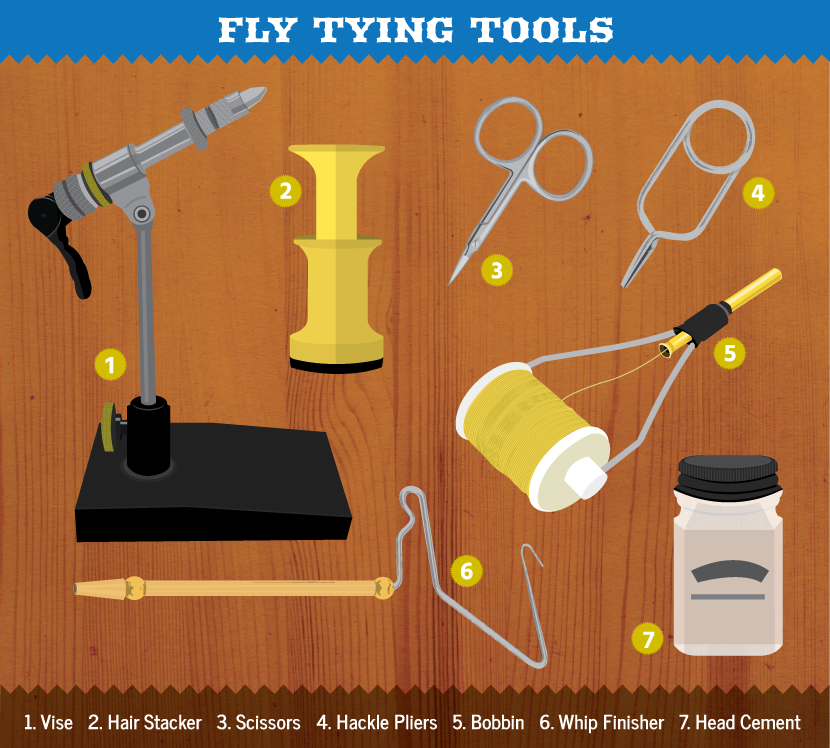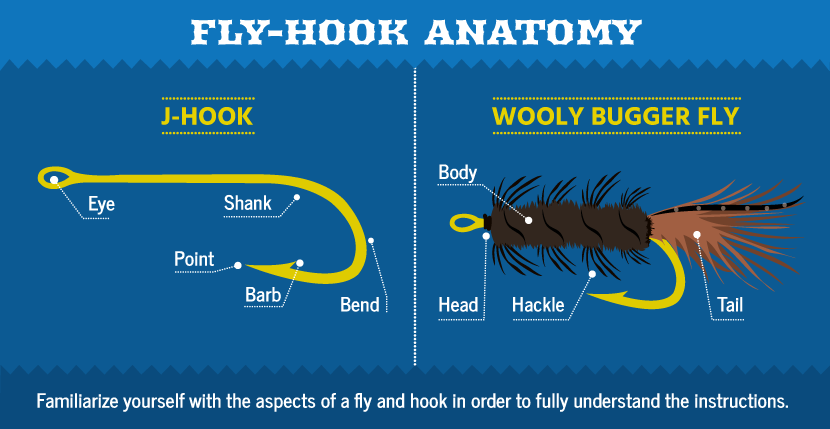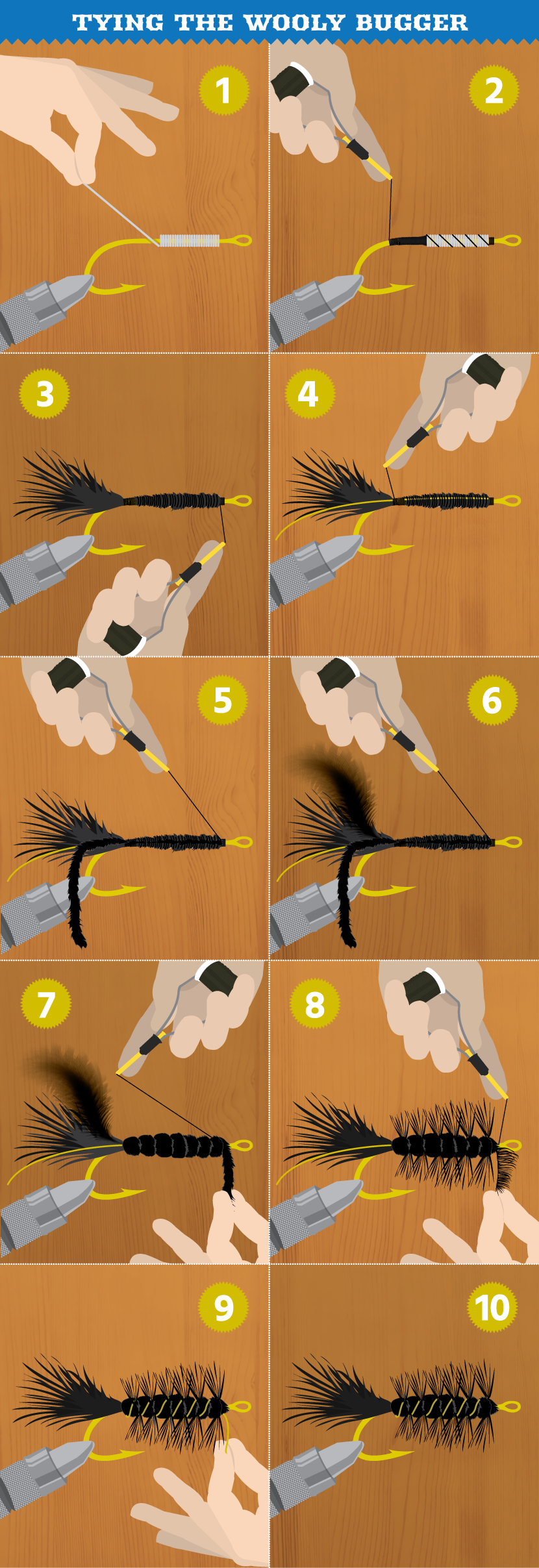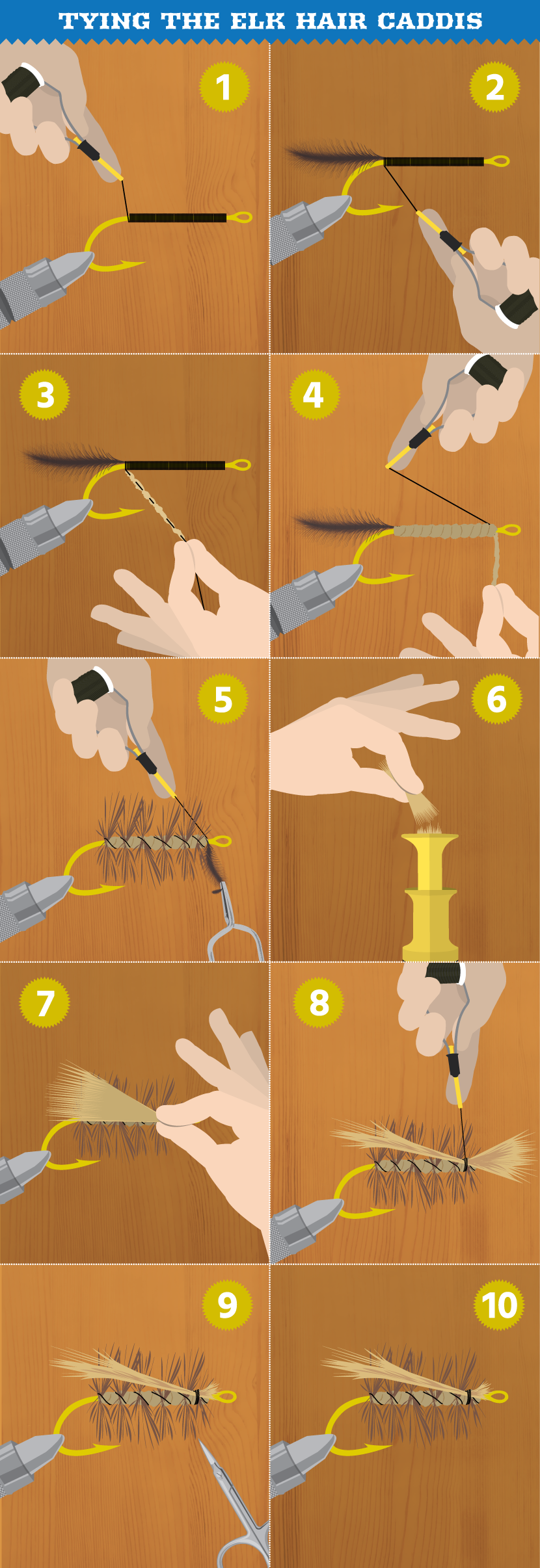Tie Your Own Flies This Winter
Article Written By; Charlie Robinton,
http://www.fix.com/
Tying your own flies is a great way to pass the time when you can’t go fishing. After the rods and reels are put away for the winter, you can fill your fly box for next season while dreaming about future fishing trips. All you need to start are a few basic tools and materials, plus a bit of knowledge.
In this article, we will discuss what you need to get started with fly tying and learn to tie two very effective trout flies: the Wooly Bugger and the Elk Hair Caddis. Tying these simple flies will teach you some fundamental techniques that serve as a good base for countless other fly patterns.
Tools and Materials
The essential tools for fly tying can be found at any good fly shop.
Vise: A vise is the most important piece of equipment for tying flies. A quality vise will firmly hold hooks of many different shapes and sizes.
Scissors: The delicate work and small-diameter thread used in fly tying require ultra-sharp, fine-pointed scissors. Fly shops sell special scissors made just for this purpose.
Bobbin: The bobbin holds the spool of thread while you wind it around the hook to secure the materials to it.
Hair Stacker: Some flies are tied using animal furs, such as deer hair or bucktail. The tips of the hair must be even before it is added to the fly. To do this, you’ll need a hair stacker.
Hackle Pliers: Hackle pliers help you hold delicate feathers when wrapping them around the hook.
Whip Finisher: A whip finisher makes a strong knot to finish off your fly and keep the materials on the hook.
Head Cement: Head cement is placed on the knot once the fly is finished to keep it from coming untied.
A good set of tools should last a lifetime, so it is worthwhile to spend on quality; avoid going for the cheapest you can find.
Now that you have the right equipment, you’ll need some materials to start your first flies. Fly tying materials vary greatly, and today there are more options than ever. Traditional materials like animal furs and feathers are still used in many flies, but modern synthetic materials like reflective mylar flash and closed-cell craft foam are also popular. A visit to a fly shop will give you an idea of the array of different materials available.
Given the range of possibilities, the best approach for the beginner is to pick one or two flies and buy the materials for those. Once you’ve tied a handful of flies and mastered the basic techniques, you can move on to new patterns, accumulating materials and learning techniques as you go. Below are recipes for tying two great beginner flies.
The Wooly Bugger
The Wooly Bugger is a classic trout fly; it has a place in the fly box of almost every serious trout angler. Why? Because it catches fish! It is a simple fly that uses just a few materials and can be tied in endless variations. We’ll start with black, as that’s one of the best colors – once you learn the technique, you can get fancy with it!
Materials:
Hook: Long-shank streamer hook, sizes 4–10
Weight: Lead wire, 0.15 diameter
Thread: Black UNI-Thread, size 6/0
Tail: Black marabou
Body: Medium black chenille
Hackle: Black Chinese saddle hackle
Rib: Medium copper wire
Tying the Wooly Bugger
1. Secure the hook in your vise. Make 10–15 tight turns of lead wire on the hook.
2. Tie the saddle feather in by its tip at the hook bend. Clip off the extra.
3. Add dubbing onto the thread by rolling small clumps around the thread with your fingers a bit at a time. Use as little as possible, covering only 1-2” of thread.
4. Wind the dubbed thread up the hook to the eye, forming a slim, tapered body.
5. Use hackle pliers to wrap the feather forward using 4 or 5 evenly spaced turns. Secure the feather at the hook eye and clip away the excess.
6. Cut a small clump of elk hair. Place the hair, tips down, into your hair stacker and tap it sharply on the table to even the ends. Remove the hair from the stacker, taking care to keep the ends even.
7. Pinching the hair between your thumb and forefinger, hold it on top of the fly and align the tips of the hair so that they match up with the bend of the hook. Holding the hair in this position with your free hand, use your other hand to secure it in place with several tight thread wraps, taking care to keep the hair on top of the hook.
8. Pull the thread tight to flare the elk hair.
9. Trim the butt ends of the hair, tie off using the whip finish tool, and add cement.
Congratulations, you’ve completed your first fly!
The Elk Hair Caddis
The Elk Hair Caddis is a classic dry fly and a staple in most trout-fishing boxes. It imitates an adult caddis fly, but it also works well as an all-around dry fly throughout the season. The name comes from the wing, which is made from hollow elk hair that keeps the fly floating on the surface.
Materials:
Hook: Dry fly hook, size 8–16
Thread: Tan UNI-Thread, size 6/0
Body: Tan rabbit-fur dubbing
Hackle: Dry-fly saddle hackle properly sized to hook
Wing: Elk hair
Tying the Elk Hair Caddis
1. Start the thread just as you did with the Wooly Bugger and lay a base all the way to the hook bend. Clip off any excess.
2. Tie the saddle feather in by its tip at the hook bend. Clip off the extra.
3. Add dubbing onto the thread by rolling small clumps around the thread with your fingers a bit at a time. Use as little as possible, covering only 1-2” of thread.
4. Wind the dubbed thread up the hook to the eye, forming a slim, tapered body.
5. Use hackle pliers to wrap the feather forward using 4 or 5 evenly spaced turns. Secure the feather at the hook eye and clip away the excess.
6. Cut a small clump of elk hair. Place the hair, tips down, into your hair stacker and tap it sharply on the table to even the ends. Remove the hair from the stacker, taking care to keep the ends even.
7. Pinching the hair between your thumb and forefinger, hold it on top of the fly and align the tips of the hair so that they match up with the bend of the hook. Holding the hair in this position with your free hand, use your other hand to secure it in place with several tight thread wraps, taking care to keep the hair on top of the hook.
8. Pull the thread tight to flare the elk hair.
9. Trim the butt ends of the hair, tie off using the whip finish tool, and add cement.
Don’t worry if your flies aren’t perfect at first. Developing the technique takes time and practice. Begin by tying in bigger sizes, practicing several of one fly before moving on to another, and using as few thread wraps as possible to avoid overcrowding the hook with material. The more flies you tie, the better they will turn out.
And remember to keep those first ones – you may not like how they look, but the fish won’t mind! You’ve got all winter to practice, so start filling those fly boxes for next season now, and have fun.
To see the original article, go to http://www.fix.com/blog/learn-how-to-tie-flies/












